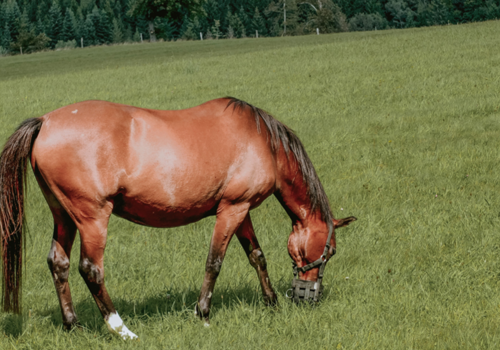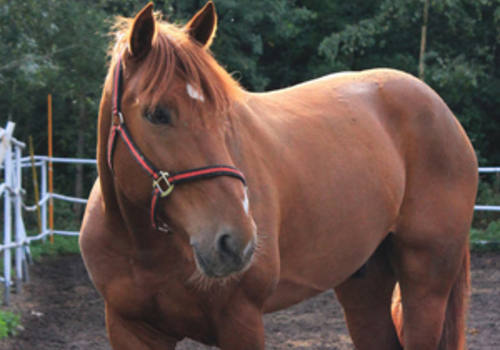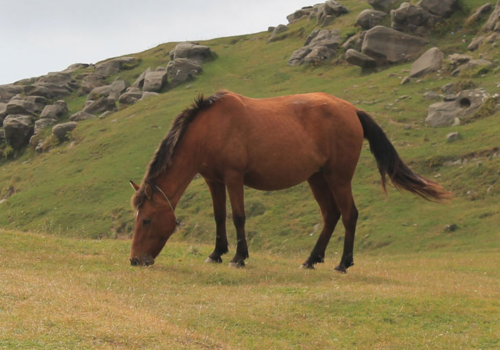
Regular care of your horse paddock is key to keeping your horses fit and healthy. Ensure your horse's pasture provides a dense and nutritious sward by using some of the simple paddock maintenance and care methods below.
For more seasonally specific paddock maintenance advice, check out our yearly planner.
Choose the Right Horse Paddock Grass Seed
One of the most important ways to improve your horse’s paddock is to ensure you choose the right horse seed grass mixture for your horse and paddock. Choosing the right one can be daunting, especially with a number of different varieties on the market. Below we’ve listed some things to consider when choosing the right grass seed mixture, if you’re still unsure please feel free to get in touch with one of our friendly team members.
- Consider the soil type of your paddock: Different grass varieties thrive in different types of soil. If your paddock has dry soil, look for grass seed mixes that are specifically designed for dry conditions. These mixes often include drought-resistant varieties that can withstand periods of low moisture.
- Think about the intended use: If you’re looking to create a new horse paddock for hay production, you’ll want to choose a grass seed mix that is high in yield and quality. On the other hand, if you’re looking to repair bare or sparse patches, you may want to choose a mix that is fast-establishing and hard-wearing. This ensures that the grass can quickly cover the ground and withstand the wear and tear from your horses.
- Consider the climate: If you live in an area with harsh, cold winters, you’ll want to choose a grass seed mix that is resistant to cold temperatures and can withstand year-round use. Look for seed mixes that include cold-tolerant varieties to ensure your paddock remains lush and green throughout the year.
- Look for grass seed mixes that promote animal health: Some grass seed mixes are specifically designed to promote animal health by including additional nutrients. These mixes can help improve the overall well-being of your horses by providing them with a nutritious and balanced diet. Look for mixes that include these extra nutrients if you’re looking to improve the health and well-being of your horses. If your horse is prone to laminitis, ensure to choose a rye-free horse paddock grass seed mixture. To find out more about laminitis, read our blog.
Overseeding Your Paddock
Overseeding is an incredibly simple and effective way to improve the quality and appearance of your horse paddock grass. The process of overseeding is where you add additional grass seeds to an existing pasture area. At Boston Seeds, we recommend doing this at least once a year.
Using a suitable paddock grass seed mixture suitable for over-seeding is the most successful and economical way to improve horse paddocks that have open swards and damaged areas. We recommend our Paddock Repair Grass Seed which is specially formulated to establish quickly without the need to disturb your horses grazing. It’s particularly good for repairing poached areas along fences and in gateways.
Overseeding can be done either by manual broadcasting or with the help of a seed spreader. We recommend using a spreader as manual spreading is incredibly time-consuming, especially in larger areas like a paddock. A spreader also ensures an even coverage which is difficult to achieve manually.
Reseeding Damaged Areas of Your Paddock
Like overseeding, reseeding helps fill out any areas of your paddock that are looking a little patchy and bare. The main difference is overseeding involves adding grass seed to existing areas of grass, whereas reseeding will fill areas that have been overgrazed. You can find out about overgrazing in our maintenance guide.
If reseeding is necessary, we recommend using either our Classic Horse Paddock Grass Seed or Triple ‘H’ Horse Paddock Grass seed. Both of these paddock grass seed mixtures are ideal for new paddocks, so will fill out any patchy areas in your paddock in no time.
The most common areas for reseeding are along fences and gateways. This is because as well as being grazed, these areas experience heavier footfall and usage. If you catch these patchy areas early enough, you can over-seed them along with the rest of your paddock.
Reseeding can also be helpful if your horse’s dietary needs have changed and you need to start growing grass with a nutrient ratio better suited to them. You can read more specific advice on choosing the right grass seed to help prevent and treat laminitis.
How to Prepare Your Paddock for Seeding
Preparing your paddock for seeding is an essential step in ensuring the success of your paddock grass seed. Here are some tips to help you prepare your paddock:
- Remove any debris: The first step is to clear your paddock of any debris, including rocks, weeds, and old grass. This will create the perfect clean slate for your new grass seed to establish itself without competition from other, undesired plants.
- Loosen the soil: Loosen the soil to a depth of about 10-15cm to allow for good drainage and aeration. This can be done using a rototiller or a similar tool. Proper soil aeration is crucial for the roots of your new paddock grass to grow strong and healthy.
- Level the ground: Level the ground to ensure that the soil is even and consistent. This will help prevent water from pooling in low spots and ensure that your paddock grass seed is evenly distributed.
- Apply a fertiliser: Apply a fertiliser to the soil to give your grass seed a boost. Choose a fertiliser that is specially formulated to provide the nutrients that young grass plants need to establish quickly and grow vigorously.
- Check the pH level: Check the pH level of your soil and adjust it if necessary. Most grasses prefer a slightly acidic to neutral soil pH, typically between 6.0 and 7.0. You can adjust the pH by adding lime to raise it or sulfur to lower it, depending on your soil’s current condition.
Harrowing to Help Rejuvenate Your Paddock
For grass that is used for grazing, it’s always advised to harrow before overseeding. Chain harrowing opens the sward and removes dead grass ready for the introduction of your grass seed. Harrowing will also help improve air circulation in the soil and root aeration. This helps water infiltration so new seeds and growing grass can be properly fed.
Harrowing has many overall benefits on the health of your soil. As well as aerating the soil, it can help break up clods and level out any bumps - creating a more even surface to sow seeds and fertiliser. While harrowing won’t remove weeds, it can help to break up moss clumps which makes it easier to then go in with moss killer and lawn feed. This helps rejuvenate the existing grassland, keep a regular sward and avoid any unnecessary injuries to the horses due to uneven ground.
Chain harrows are some of the most popular tools for paddock harrowing and they’re relatively inexpensive. Another upside is chain harrows can be used on slightly damp soil, which is a common sight in spring. For larger paddocks, you can use a harrow attached to your tractor but be aware, this should only be done on dry soil.
It’s important to give new seedlings every chance to compete with established grass, so nitrogen applications should be delayed or reduced as this stimulates growth in existing grass.
Fertilisation to Keep Your Soil Full of Nutrients
Making sure you have the right fertiliser for your paddock maintenance is absolutely essential as your horse relies on grass for many of its nutrients. Before fertilising, test the soil to establish the pH. This will help you understand what nutrients your soil actually needs for optimal health. The optimal pH is 6.5 and samples should be taken from February through to April or September through to December. It’s important to take regular readings to ensure you have a steady understanding of your soil’s pH level. Taking just one sample can be misleading and can lead to the wrong fertiliser being used.
If the pH is acidic, applying lime will help to reduce the acidity enabling the grass to get all of the necessary nutrients. It’s important to deal with the acidity level of soil as soon as possible as acidic soil will decrease plant nutrients, such as phosphorus and molybdenum. Not only does it take nutrients, but it can actually provide toxic levels of aluminium and manganese which can kill off the grass.
Paddock fertiliser is best applied in the spring and autumn. Granular fertiliser can be applied with a spreader and like spreading grass seed, it’s far quicker than doing it by hand and ensures even coverage to avoid clumping. It’s important to make sure your fertiliser is applied evenly or you can end up with patchy grass growth which encourages overgrazing in specific areas.
Paddock Rotation to Avoid Overgrazing
Paddock rotation is one of the simplest ways to avoid overgrazing, as we discuss in more detail in our maintenance guide. Overgrazing is essentially where a specific area is grazed continuously without giving the grass time to recover and regrow. It will end up with dead patches of grass that need to be reseeded and extra fertilisation to replace all of the soil lost nutrients.
Regularly Weed and Keep a Check on Harmful Plants
Removing weeds should be a priority when caring for your paddock. Weeds are harmful to the overall health of your paddock grass as they will suck up all the nutrients from the soil, leaving very little for your grass. One of the more urgent reasons though is that many common weeds can be incredibly harmful to your horse’s health. You can use a selective weedkiller to remove weeds without damaging your grass.
Read our guide on toxic plants to learn about common harmful plants, how to deal with them and symptoms of ingestion.
Common Issue to Look Out For When Improving/Creating a Horse Paddock
Even with proper preparation and care, issues can still arise when seeding your paddock. Here are some common issues and their solutions:
- Poor germination: If your grass seed is not germinating, it may be due to poor soil quality, inadequate moisture, or insufficient light. Check your soil quality and adjust your seeding rate accordingly. Ensure that the soil is kept consistently moist during the germination period and that the area receives adequate sunlight.
- Pests: Pests such as slugs and snails can damage your grass seed. Use a pest control method to deter pests.
- Diseases: Diseases such as powdery mildew and rust can affect your grass seed. Use a fungicide to treat diseases, and consider using a disease-resistant grass seed mix. Ensure proper air circulation and avoid overwatering, as excessive moisture can promote the growth of fungal diseases.
-----------------------------------
Have a question about horse paddock grass? Our team of experts are on hand to help, just get in touch!
---------
How we can help!
At Boston Seeds we take pride in excellent customer service. If you're growing a paddock from scratch but unsure how much grass seed you need, our handy Grass Seed Calculator can help you figure it out in just a few clicks!
With Next Day Delivery on hundreds of items too, choosing from our extensive range of grass seed couldn't be easier. Ordering regularly or looking for large volumes? Click here to apply for a trade account today - we review all applications within one working day. If you have any questions, then please get in touch.


